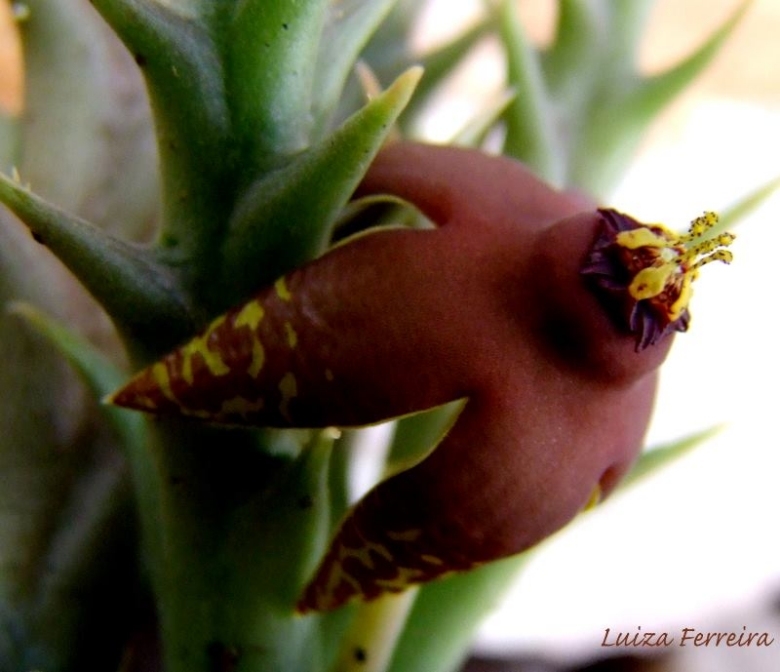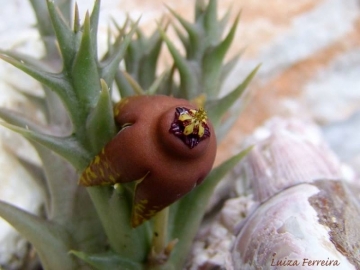




Your support is critical to our success.

Origin and Habitat: Zimbabwe (N,E,S), Bikita Distr and Mozambique. Restricted to the lower parts of the Eastern Highlands as well as along the Sabi River and its tributaries in the Save-Limpopo lowveld.
Habitat and ecology: Orbea umbraculaSN|31263]]SN|31263]] grows in drier granite sands in rocky areas or in Brachystegia woodland, in open areas or in the shade of small bushes.
Altitude range: 300 - 1000 metres above sea level.
Synonyms:
- Orbea umbracula (M.D.Hend.) L.C.Leach
- Stapelia umbracula (M.D.Hend.) P.V.Heath
- Stultitia umbracula M.D.Hend.
Description: Orbea umbraculaSN|30634]]SN|31263]] is a low-growing, tufted, perennial succulent with mottled greyish branches forming small lax mats. The flowers are very peculiar, usually directed sideways with the entire corolla corolla lobes strongly reflexed, 1-8 flowers develop in succession, from a thickened peduncle. Flowers with corolla lobes strongly reflexed, clasping the pedicel, chocolate-brown, mottled or striped with yellow at the tips of the lobes, rarely rusty-brown. Corona lobes yellow, spreading. It is closely allied to Orbea halipedicolaSN|31263]]SN|30634]].
Derivation of specific name: umbraticola Latin 'umbra', shade; and Latin '-cola', inhabiting.
Stem: Squat, to about 75 mm long and 8 mm in diameter, branched 2 cm above the ground, 4-angled, sides more or less furrowed with acute, ascending or widely divergent tubercle teeth up to 20 mm long with denticles present.
Leaves: Rudiments acute.
Inflorescence: l- to 8-flowered, usually erect, rarely oblique or pointing
outwards; peduncle often as thick as the stems, terete, stumpy, erect.
Flower: Flower buds 5-angled-ovoid, acute, sides concave. Peduncles 30– 40 mm long, 2 cm in diameter, rarely spreading. Sepals 6 mm long, 3 mm wide. The corolla up to 5 cm across, inversely campanulate and strongly reflexed as if ready for flight. The prominent annulus or swollen disc and lower third of the lobes are smooth and liver-coloured. the tips of the lobes rugose with yellowish-green markings, the margins shortly ciliate. Corolla outside yellow-green. Annulus 4 X 7.5 mm in diameter ascending, glabrous, inside finely pubescent. Corolla lobes blotched with yellow, 16 x 9 mm, strongly revolute and with the tips embracing the pedicel, margins cartilaginous. Corona 7.5 mm in diameter, convex, on a stalk 2-3 mm long. Inner corona, dull maroon, lobes 2 mm long, 1.5 - 2 mm wide, square, fleshy, apically irregularly toothed. Outer corona-lobes yellow with reddish markings, lobes 4 - 5 mm long, l mm thick, elongate, apical appendage filifonn, erect, meeting each other above the style head.
Bibliography: Major references and further lectures
1) Focke Albers, Ulrich Meve “Illustrated Handbook of Succulent Plants: Asclepiadaceae: Asclepiadaceae” Volume 4 Springer, 2002
2) Doreen Court “Succulent Flora of Southern Africa” CRC Press, 01/Jun/2000
3) Bruyns, P.V. “Monograph of Orbea and Ballyanthus (Apocynaceae-Asclepiadoideae-Ceropegieae)” Systematic Botany Monographs 63 Pages 160 - 162. 2002
4) Mapaura, A. (2002). "Endemic Plant Species of Zimbabwe." Kirkia 18(1) Page 133.
5) Hyde, M.A., Wursten, B.T., Ballings, P. & Coates Palgrave, M. (2015). "Flora of Zimbabwe: Species information: Orbea umbracula."
http://www.zimbabweflora.co.zw/speciesdata/species.php?species_id=146650, retrieved 27 May 2015
6) Urs Eggli, Leonard E. Newton “Etymological Dictionary of Succulent Plant Names” Springer Science & Business Media, 29 June 2013
7) "Fl. Pl. South Africa" 35: t.1374 (1962).
8) "List South. African Succ. Pl." : 27 (1997).
9) "Syst. Bot. Monogr". 63: 158-160 (2002).

Orbea umbracula Photo by: Luiza Ferreira
The gallery now contains thousands of pictures, however it is possible to do even more. We are, of course, seeking photos of species not yet shown in the gallery but not only that, we are also looking for better pictures than those already present. Read More...
Cultivation and Propagation: Orbea umbraculaSN|31263]]SN|31263]] is an easy obliging blooming plant when mature, that it is happy in any average succulent house.
Potting: Since roots are quite shallow, use a soft and incoherent cactus mix or add extra perlite or pumice to regular soil potting soil, and clay pots help the plants to dry out between watering.
Waterings: Orbeas require moderately watering through the growing season but enjoy plenty of water and some fertiliser in hot weather, this helps them to flower freely. Water more sparingly in winter according to temperatures. But, as with most asclepiads, it is unwise to leave them wet in cold weather.
Fertilization: Fertilizers for succulent plants must be rich in potassium, but poor in nitrogen, to avoid the plants from developing excess vegetation, which is easily attacked by fungal diseases.
Sun Exposure: As with many succulents, they prefer to grow in the light shade of scrubby shrubs or between rocks where they get some shade during the day. In summer it is advisable to position this plant in a partially shady place, where it is exposed to direct sunlight only during the coolest hours of the day.
Hardiness: These plants don't like cold weather, therefore in the Spring it is best to set them outside only when the temperatures are above 15°C. Can endure temperatures below 5°C for short period, but only if the soil stays completely dry.
Pest and diseases: Orbeas species vary in their susceptibility to rotting, but are generally fairly easy to grow, especially if kept pest-free. They are very susceptible to stem and root mealy bugs, and damage from these may well initiate fungal attack. If you do have problems with a stem or with basal rotting, you can reliably isolate the healthy parts, dry them off, and re-root them in moist compost.
Cultural Practices: Re-pot every 2 years.
Propagation: Easiest with stem cuttings. Allow cuttings to dry a day before planting. Stems must be laid (Not buried) on gritty compost and will then root from the underside of the stems. It can also be increased from seeds sowing in spring in moist, sandy peat moss. Barely cover seeds. Seeds germinate quickly.
| Your Actions | |
|---|---|
| Back to Orbea index | |
| Back to Asclepiadaceae index | |
 |
Back to Succulents Encyclopedia index |
Privacy stantement - Terms and conditions - How to cite - About us - Feedback - Donate



